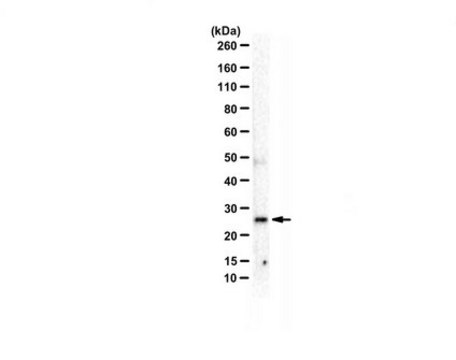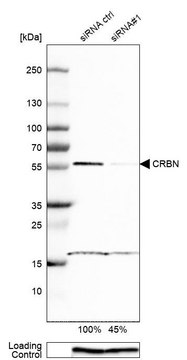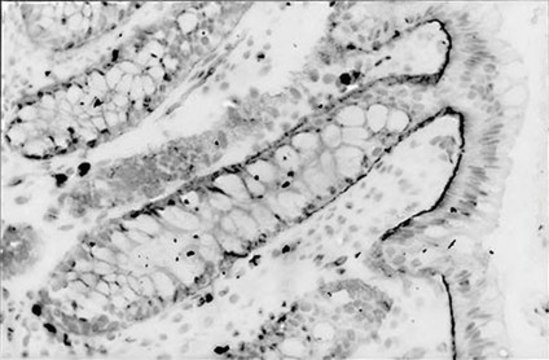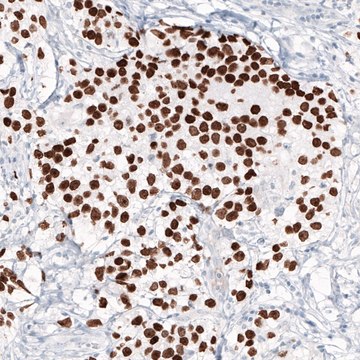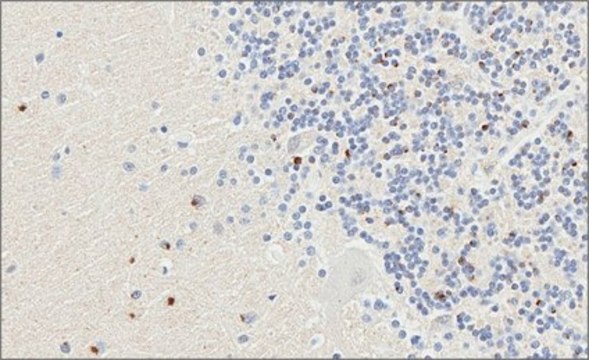All Photos(1)
Synonym(s):
C9-L, C9orf72 Long isoform, Protein C9orf72 Long isofrom
UNSPSC Code:
12352203
eCl@ss:
32160702
Recommended Products
biological source
rabbit
antibody form
affinity isolated antibody
antibody product type
primary antibodies
clone
polyclonal
species reactivity
human
technique(s)
immunofluorescence: suitable
immunohistochemistry: suitable
immunoprecipitation (IP): suitable
western blot: suitable
isotype
IgG
NCBI accession no.
UniProt accession no.
shipped in
ambient
target post-translational modification
unmodified
Gene Information
human ... C9orf72(203228)
General description
Protein C9orf72 (UniProt: Q96LT7) is encoded by the C9orf72 gene (Gene ID: 203228) in human. Expansion of a GGGGCC (G4C2) hexanucleotide repeat sequence in the non-coding region of human chromosome 9 open reading frame 72 or C9orf72 is the most common genetic abnormality in familial and sporadic frontotemporal dementia (FTD) and motor neuron disease (MND), with amyotrophic lateral sclerosis (ALS) as the most frequent form. The majority of normal human C9orf72 alleles carry less than 20 repeats, whereas large expansions consisting of hundreds or thousands of repeats lead to disease. C9orf72 generates three transcripts through alternative splicing that encode 2 protein isoforms; a long isoform of about 54 kDa (termed C9-L), corresponding to variants 2 and 3, and a short isoform of about 24 kDa (termed C9-S) corresponding to variant 1. Both isoforms are widely expressed, including kidney, lung, liver, heart, testis and several brain regions, including cerebellum, and frontal cortex. Both, C9-L and C9-S are reported to display distinct subcellular localizations in cerebellar Purkinje cells of both c9-ALS and nonc9-ALS cases. C9-L is shown to be spread diffusely throughout the cytoplasm, whereas C9- S is localized to the nuclear membrane of Purkinje cells of both c9-ALS and non-c9-ALS cases. Also, C9-L is shown to be present mainly in the high-salt Triton and urea-soluble fractions, whereas C9-S is shown to be abundant in both the low- and high-salt Triton fractions, indicating differences in their subcellular localizations. Antibodies generated against C9-L and C9-S offer advantage because they allow characterization of different biochemical profiles, region-specific changes, and subcellular localizations that is not possible with antibodies generated against the common N-terminal region.
Specificity
This polyclonal antibody specifically detects the long isoform (C9-L) isoformm of C9orf72. It targets an epitope within 14 amino acids from the C-terminal region.
Immunogen
KLH-conjugated linnear peptide corresponding to 14 amino acids from the C-terminal half of the long form of human C9orf72.
Application
Anti-C9ORF72 (long form) Antibody, Cat. No. ABN1645, is a highly specific rabbit polyclonal antibody that targets C9ORF72 and has been tested in Immunofluorescence, Immunohistochemistry, and Immunoprecipitation, and Western Blotting.
Immunoprecipitation Analysis: A representative lot detected C9ORF72 (long form) in N2a cells (Xiao, S., et. al. (2015). Ann Neurol. 78(4):568-83).
Western Blotting Analysis: A representative lot detected C9ORF72 (long form) in different regions of the central nervous system (Xiao, S., et. al. (2015). Ann Neurol. 78(4):568-83).
Immunohistochemistry Analysis: A representative lot detected C9ORF72 (long form) in spinal motor neurons (Xiao, S., et. al. (2015). Ann Neurol. 78(4):568-83).
Immunofluorescence Analysis: A representative lot detected C9ORF72 (short form) in lumbar spinal cord tissue (Xiao, S., et. al. (2015). Ann Neurol. 78(4):568-83).
Western Blotting Analysis: A representative lot detected C9ORF72 (long form) in different regions of the central nervous system (Xiao, S., et. al. (2015). Ann Neurol. 78(4):568-83).
Immunohistochemistry Analysis: A representative lot detected C9ORF72 (long form) in spinal motor neurons (Xiao, S., et. al. (2015). Ann Neurol. 78(4):568-83).
Immunofluorescence Analysis: A representative lot detected C9ORF72 (short form) in lumbar spinal cord tissue (Xiao, S., et. al. (2015). Ann Neurol. 78(4):568-83).
Research Category
Neuroscience
Neuroscience
Quality
Evaluated by Western Blotting in human cerebellum tissue lysate.
Western Blotting Analysis: A 1:500 dilution of this antibody detected C9ORF72 (long form) in 10 µg of human cerebellum tissue lysate.
Western Blotting Analysis: A 1:500 dilution of this antibody detected C9ORF72 (long form) in 10 µg of human cerebellum tissue lysate.
Target description
~51 kDa observed; 54.33 kDa calculated. Uncharacterized bands may be observed in some lysate(s).
Physical form
Affinity Purified
Format: Purified
Purified rabbit polyclonal antibody in PBS with 0.02% sodium azide.
Storage and Stability
Stable for 1 year at 2-8°C from date of receipt.
Other Notes
Concentration: Please refer to lot specific datasheet.
Disclaimer
Unless otherwise stated in our catalog or other company documentation accompanying the product(s), our products are intended for research use only and are not to be used for any other purpose, which includes but is not limited to, unauthorized commercial uses, in vitro diagnostic uses, ex vivo or in vivo therapeutic uses or any type of consumption or application to humans or animals.
recommended
WGK
WGK 2
Flash Point(F)
Not applicable
Flash Point(C)
Not applicable
Regulatory Information
新产品
Certificates of Analysis (COA)
Search for Certificates of Analysis (COA) by entering the products Lot/Batch Number. Lot and Batch Numbers can be found on a product’s label following the words ‘Lot’ or ‘Batch’.
Already Own This Product?
Find documentation for the products that you have recently purchased in the Document Library.
Christopher P Cali et al.
Acta neuropathologica, 138(5), 795-811 (2019-07-22)
Microsatellite repeat expansion disease loci can exhibit pleiotropic clinical and biological effects depending on repeat length. Large expansions in C9orf72 (100s-1000s of units) are the most common genetic cause of amyotrophic lateral sclerosis (ALS) and frontotemporal degeneration (FTD). However, whether
Alexandra M Nicholson et al.
Acta neuropathologica communications, 6(1), 42-42 (2018-06-02)
Loss-of-function mutations in progranulin (GRN) and a non-coding (GGGGCC)n hexanucleotide repeat expansions in C9ORF72 are the two most common genetic causes of frontotemporal lobar degeneration with aggregates of TAR DNA binding protein 43 (FTLD-TDP). TMEM106B encodes a type II transmembrane
Our team of scientists has experience in all areas of research including Life Science, Material Science, Chemical Synthesis, Chromatography, Analytical and many others.
Contact Technical Service